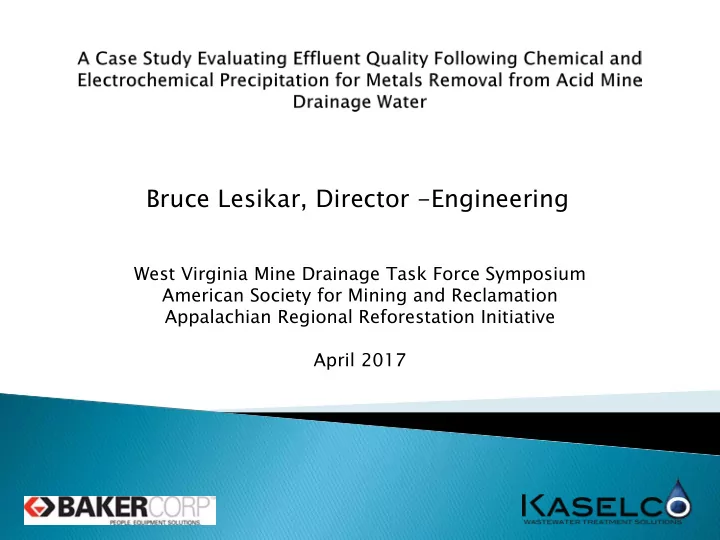

Bruce Lesikar, Director -Engineering West Virginia Mine Drainage Task Force Symposium American Society for Mining and Reclamation Appalachian Regional Reforestation Initiative April 2017
Overview • What is electrocoagulation? • History of electrocoagulation: Old technology with a new beginning • Why is electrocoagulation important for our future? • Comparison of conventional chemical precipitation and electrochemical precipitation for metals reductions.
Water treatment approaches • Physical • Biological • Chemical • Electrochemical
Electrochemical treatment cell Power supply Sacrificial plates Monopolar connection Bipolar connection Huijuan Liu, Xu Zhao, and Jiuhui Qu. 2010. Electrocoagulation in Water Treatment
Ion Reactions
Electrocoagulation History • 1906 - Dieterich Patent • Bilge Water Treatment • 1980’s - Revival • 1988 - Article in Products Finishing Magazine • 2000’s - KASELCO Patents • 2010 – Textbook describing the process • 2010’s – Rapid expansion of companies in market
General Benefits • Reduced treatment cost • Reduced chemical usage • Reduced sludge generation • Simple operation • Broad spectrum of treatment • Cleaner effluent Less salt in discharge Lower concentration of contaminants
What about scalability? Reactor Sizes & Capacities (Nominal) • Sur-Flo Reactors • Hi-Flo Reactors ▫ 2.5 GPM ▫ 25 GPM ▫ 10 GPM ▫ 100 GPM ▫ 25 GPM ▫ 200 GPM ▫ Link Multiple Units ▫ 400 GPM ▫ 600 GPM (100 GPM) ▫ 800 GPM ▫ 1200 GPM ▫ Link Multiple Units
Fixed installations
Mobile installations
Why is electrocoagulation important for our future? • Water reuse • Dissolved solids become suspended solids ▫ Therefore, physical separation is possible • Limit chemical addition • Removes a broad spectrum of industrial pollutants
• Textile and Other Dyes • Mixed Metals and Organics • Oil & Grease • Bacteria/solids - Sewage Plants • Arsenic Removal • Metals in Mine Water • Plating Operations • Die Casting • Flowback/Produced water • Desalination
Effluent Water Quality Raw CaOH NaOH EC Test 1 EC Test 2 Constituent (mg/L) (mg/L) (mg/L) (mg/L) (mg/L) pH Conductivity Test Aluminum 57.4 <0.1 <0.1 0.103 <0.1 (S.U.) (µS/cm) Arsenic <0.02 <0.02 <0.02 <0.02 <0.02 CaOH 6.92 1,661 Barium <0.02 <0.02 <0.02 <0.02 <0.02 NaOH 6.79 2,030 Boron <0.5 <0.5 <0.5 <0.5 <0.5 Cadmium <0.01 <0.01 <0.01 <0.01 <0.01 EC Test 1 7.75 1,535 Calcium 84.5 311 94.9 278 258 EC Test 2 8.17 1,400 Chromium 0.0223 <0.02 <0.02 <0.02 <0.02 Copper 0.252 <0.02 <0.02 <0.02 <0.02 Iron 17.7 <0.2 <0.2 <0.2 <0.2 Conventional Chemical Lead <0.02 <0.02 <0.02 <0.02 <0.02 Treatment Magnesium 60.6 48.5 65.6 32.5 28.9 Manganese 10.8 5.89 10 0.68 0.238 Electrochemical Treatment Molybdenum <0.02 <0.02 <0.02 <0.02 <0.02 Nickel 1.02 0.144 0.955 <0.02 <0.02 Potassium 1.21 3.19 2.85 10.1 10.1 Selenium <0.02 <0.02 <0.02 <0.02 <0.02 Silicon 23.6 2.98 8.63 <2 <2 Silver <0.01 <0.01 <0.01 <0.01 <0.01 Sodium 3.05 4.0 243 3.62 3.42 Strontium 0.315 0.402 0.316 0.364 0.339 Zinc 1.71 <0.05 0.5 <0.05 <0.05
Effluent Water Quality Raw CaOH NaOH EC Test 1 EC Test 2 Constituent (mg/L) (mg/L) (mg/L) (mg/L) (mg/L) pH Conductivity Test Aluminum 42.1 <0.1 <0.1 <0.1 <0.1 (S.U.) (µS/cm) Arsenic <0.02 <0.02 <0.02 <0.02 <0.02 CaOH 6.96 2,050 Barium <0.02 <0.02 <0.02 <0.02 <0.02 NaOH 7.07 2,200 Boron <0.5 <0.5 <0.5 <0.5 <0.5 Cadmium <0.01 <0.01 <0.01 <0.01 <0.01 EC Test 1 8.07 1,881 Calcium 120 248 139 229 221 EC Test 2 8.16 1,610 Chromium <0.02 <0.02 <0.02 <0.02 <0.02 Copper 0.129 <0.02 <0.02 <0.02 <0.02 Iron 1.42 <0.2 <0.2 <0.2 <0.2 Conventional Chemical Lead <0.02 <0.02 <0.02 <0.02 <0.02 Treatment Magnesium 80.6 84.5 85.5 62.1 28.8 Manganese 24.6 23.6 23.2 4.1 0.53 Electrochemical Treatment Molybdenum <0.02 <0.02 <0.02 <0.02 <0.02 Nickel 1.21 0.991 0.969 <0.02 <0.02 Potassium 3.94 9.38 5.55 7.67 12.4 Selenium <0.02 <0.02 <0.02 <0.02 <0.02 Silicon 15.6 4.6 4.59 <2 <2 Silver <0.01 <0.01 <0.01 <0.01 <0.01 Sodium 16.5 18.3 162 18.7 14 Strontium 0.35 0.396 0.347 0.403 0.329 Zinc 2.01 0.285 0.281 <0.05 <0.05
Summary Calcium and sodium hydroxide chemical precipitation will • reduce aluminum and iron concentrations in acid mine drainage water. Conventional chemical treatment has limited success for • reducing additional metals at a neutral pH range. Calcium hydroxide paired with EC will reduce aluminum and • iron to low level detection limits; additional metal reductions in magnesium, manganese, nickel, silicon, and zinc. Calcium hydroxide and EC provides lower conductivity • effluent water compared to conventional chemical metal precipitation. Calcium hydroxide and EC does not require the addition of • salts for metals precipitation.
Recommend
More recommend